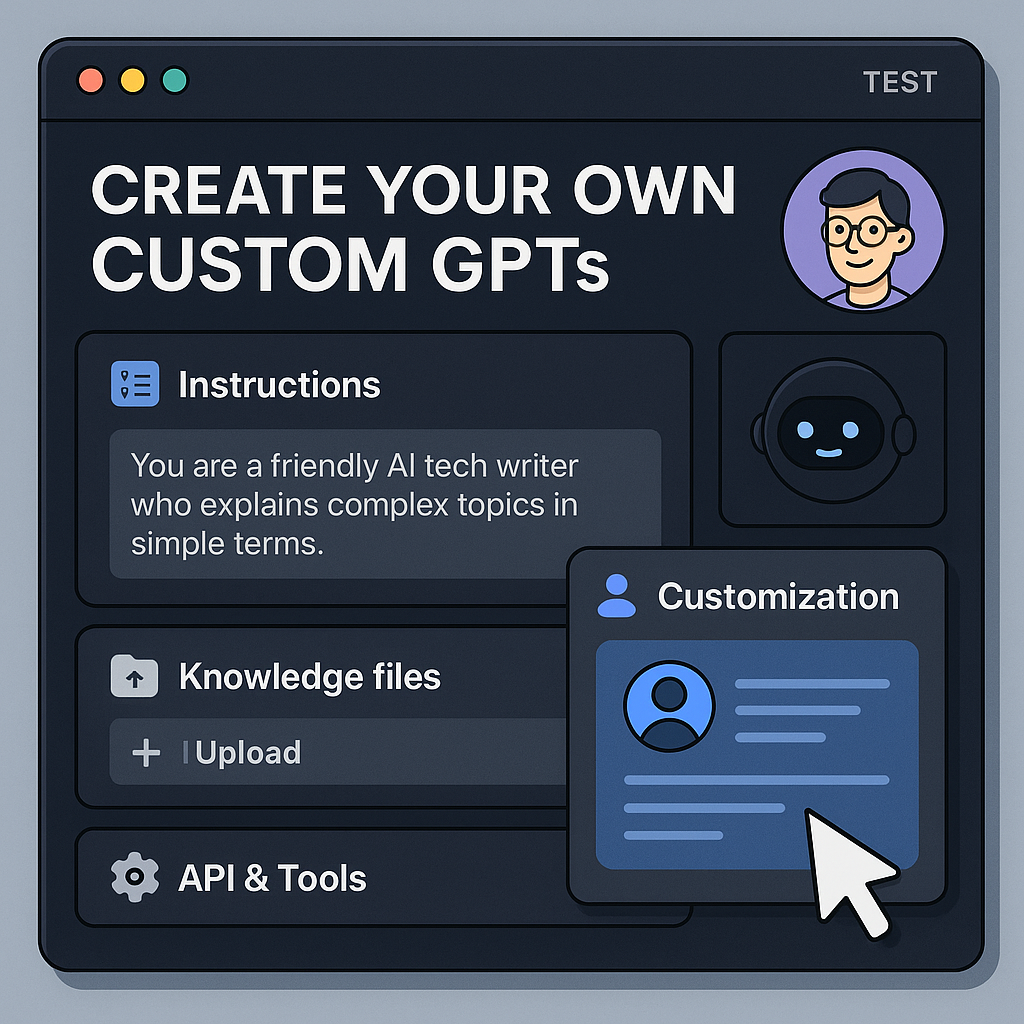In 2025, one-size-fits-all AI is officially outdated.
Whether you’re a marketer, developer, or creator, you now have the ability to build Custom GPTs — AI assistants fine-tuned for your unique goals, tone, and workflows.
OpenAI’s Custom GPTs make it easier than ever to design your own AI model—no API setup, no coding. In minutes, you can build a GPT that drafts emails like you, answers support tickets in your brand voice, or helps you brainstorm content ideas tailored to your audience.
Before diving in, check out 7 Proven ChatGPT Techniques Every Advanced User Should Know — it lays the foundation for structured prompt design and role-based customization.
1. What Exactly Are Custom GPTs?
Custom GPTs are personalized versions of ChatGPT you can create by giving them:
- Specific instructions on how to behave
- Custom knowledge files or data
- Unique APIs or tools for extended functionality
They don’t require retraining models or writing Python code — you simply configure them using an intuitive builder inside ChatGPT.
Think of it as building a digital teammate that “gets” your style.
If you love no-code creation, you’ll enjoy How to Use GPTs Like a Pro: 5 Role-Based Prompts That Work, which teaches you the logic behind creating specialized AI personalities.
2. Why Custom GPTs Matter
Most users treat ChatGPT like a Swiss Army knife — versatile but generic.
Custom GPTs turn that general-purpose model into a precision tool.
Here’s why that matters:
- 🧠 Context retention: Each GPT remembers your preferences and workflow.
- ⚙️ Efficiency: Automate repeat tasks like content generation or support queries.
- 🎨 Brand consistency: Enforce tone, style, and persona across all outputs.
It’s the same mindset explored in Unlock Your Potential with the Digital Copilot Mindset — treating AI as a partner, not just a tool.
3. Step-by-Step: How to Create a Custom GPT
Step 1: Open the GPT Builder
Inside ChatGPT (Pro version), click “Explore GPTs” → “Create.”
Step 2: Define Instructions
This is where you teach your GPT what to do. You’ll see prompts like:
- “What should your GPT do?”
- “How should it respond?”
Here’s an example:
“You are a friendly but detail-oriented tech writer. You help readers understand AI concepts through simple explanations and practical examples.”
You can refine tone, depth, and even include step-by-step teaching styles.
Step 3: Upload Custom Data
You can add knowledge files (PDFs, guides, or datasets) so your GPT references them directly — ideal for company manuals, course materials, or product info.
For example, if you run a startup, your GPT can answer FAQs using internal docs — no need for API calls.
Step 4: Add APIs or Tools (Optional)
Want your GPT to fetch data, summarize websites, or interact with Google Sheets?
Add API connections right inside the builder — similar to automations covered in How to Use ChatGPT and Zapier to Automate Your Content Calendar.
Step 5: Test, Adjust, Publish
Once ready, test your GPT. Adjust its tone, responses, or instructions based on results.
You can publish privately or share it publicly in the Explore GPTs gallery.
4. Examples of What You Can Build
Here are a few ideas to spark inspiration:
- AI Research Assistant: Summarizes arXiv papers (see Reading Your First AI Research Paper)
- Content Workflow GPT: Helps schedule posts and generate SEO outlines.
- Coding Companion: Assists with debugging or project setup (related to Cursor vs GitHub Copilot: Which AI Code Assistant Is Better for Developers?)
- Customer Support Bot: Responds with empathy and consistent brand tone.
If you want to learn how to extend these GPTs further, check out Prompting for Autonomy: Designing Better Prompts for AI Agents.
5. Tips for Optimizing Your Custom GPT
To make your GPT smarter and more aligned with your goals:
✅ Use structured instructions with examples.
✅ Test edge cases — feed it difficult prompts.
✅ Add context files for specialized topics.
✅ Regularly update data as your needs evolve.
You can manage and version these iterations using techniques from Version Control for Prompts: Tracking What Actually Works.
6. Beyond Custom GPTs: The Future of AI Personalization
Custom GPTs are just the beginning.
They hint at a broader shift toward agentic AI — systems that understand goals, take actions, and collaborate intelligently.
If you’re curious about this future, explore Beginners Guide to AI Agents: Smarter, Faster, More Useful and How to Adopt the Agentic AI Mindset in 2025.
The line between “user” and “AI developer” is blurring fast — and Custom GPTs are the gateway.
Conclusion: From User to Creator
The biggest shift in AI isn’t bigger models — it’s personalization.
Custom GPTs let anyone, regardless of technical skill, design AI that truly reflects their workflow, creativity, and goals.
Whether you’re a writer, analyst, or entrepreneur, your first Custom GPT could replace hours of repetitive work and spark entirely new ideas.
For more inspiration, dive into Creating Your Own AI Writing Assistant: A Complete Tutorial — it’s the perfect next step once your Custom GPT is live.



